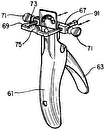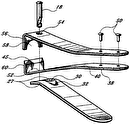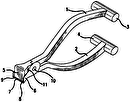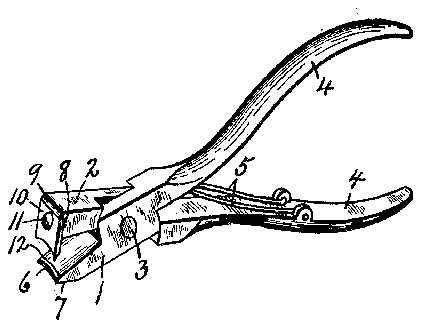
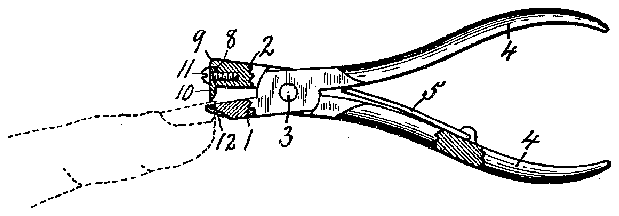
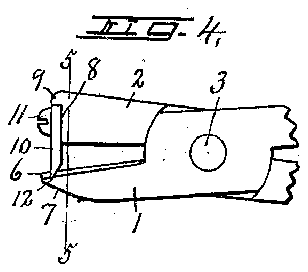
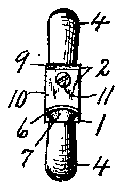
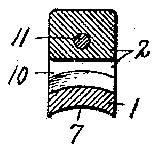
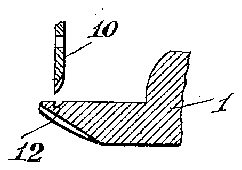
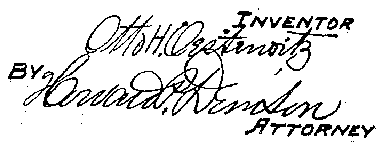
- 1jaw
- 2jaw
- 6extension
- 9rib
- 12i went j
- 21patented 1m
Description
0. H. OESTERWITZ.v
FINGER NAIL TRIMMER.
APPLICATION FILED JULY 2, 1919.
1,363,164. Patented 1m 21, 1920.
1 5' I WENT J 12 I I Q.
GFFICE.
OTTO H. OESTERWITZ, OF SYRACUSE, NEW YORK.
FINGER-NAIL TRIMIVIER.
Application filed. July 2,
To all whom it may concern Be it known that I, Or'ro H. Ons'rnnwrrz, a citizen of Germany, and resident of Syracuse, in the county of Onondaga, in the State of New York, have invented new and useful Improvements in Finger-Nail Trimmers, of which the following, taken in connection with the accompanying drawings, is a full, clear, and exact description.
This invention relates to certain improvements in finger nail trimmers, and more particularly to the construction of the jaws by which the ends of the nails may be severed.
The main object is to provide the jaws with simple and efficient means for cutting the free edges of the nails uniform distances from their junction with the cuticle of the fingers, and at the same time to reduce to a minimum the possibility of cutting into the more sensitive portions of the flesh.
In other words, I have sought to utilize the outer end of one jaw as a gage adapted to enter between the free edge of the nail and flesh without crowding the flesh back, and also to serve as a support for the nail, while the other jaw carrying the cutting edge is brought into cutting coaction with the first-named jaw a certain distance from the free edge of first-named jaw thereby assuring the cutting of the nails a uniform distance from its junction with the cuticle and avoiding the possibility of mutilating the flesh.
Other objects parts of the device will be the following description:
In the drawings,-
Figure 1 is a perspective view of a finger nail trimmer embodying the various features of my invention.
Fig. 2 is a side elevation, partly in section, of the same trimming device in the operation of clipping a finger nail shown by dotted lines.
Fig. 3 is an end view of the same device.
Fig. 4 is an enlarged side elevation of the jaws and their connecting pivot, the handles being broken away and the jaws in their closed position.
Fig. 5 is a transverse sectional view taken on line 5-5, Fig. l.
Fig. 6 is an enlarged longitudinal sectional view of the front end of the lower jaw.
As illustrated, this device comprises a pair of jaws -*1- and -2- pivoted to each and uses relating to specific brought out in Specification of Letters Patent.
Patented Dec. 21, 1920.
1919. Serial No. 308,208.
other at 3 and provided with suitable operating handles -l which are spring pressed apart to open the jaws by a spring The inner face of the jaw -1 is convexed in cross-section and extends a predetermined distance beyond the outer end face of the cutting jaw -2- to form what may be termed a gage extension -6- adapted to enter between the free edges of the nail and cuticle or flesh of the finger for determining the margin of free nail to be left after severing the protruding edge thereof and which enables the nails of all the fingers to be trimmed with a uniform margin without in any way crowding or mutilating the flesh during the cutting operation. In order that this gage extension 6- may readily enter between the nail and flesh, it is made relatively thin by beveling the lower face -7 thereof at an acute angle to the upper face, Said beveled face -7- being concaved transversely to conform as closely as possible to the transverse contour of the flesh adjacent the nail.
The outer end face of the jaw 2 is provided with a transverse recess -8 extendingfrom the inner face thereof to a line a short distance from the outer face thus forming a transverse rib -9- which constitute the upper wall of the recess S-.
A cutting blade -l0 has its upper end seated in this recess -8 and against the rib 9 and is held in place by a clamping screw -1l-.
The outer face of the blade -10 is flat and its inner edge projects some distance be yond the inner face of the main body of the jaw -2- toward the jaw -1, the free inner edge thereof being beveled inwardly and forwardly from the outer fiat face so as to draw the severed portion of the nail away from the main body thereof during the cutting operation, and is concaved longitudinally to conform to the convex face 0 the jaw 1-.
The distance between the axis of movement of the jaws and the outer face of the cutting edge of the blade 10- is somewhat less than the distance between the same axis and outer end face of the jaw -1- so as to cause said cutting edge to engage the inner face of the opposite jaw a distance from the outer ed e of the last-named jaw corresponding to the length of the gage extension -6 and to leave a corresponding margin of the free portion of the nail.
The lower face of the extension 6 of the jaw 1 is concaved in cross-section and substantially parallel with the convex upper face to conform to the transverse contour of the flesh of the finger adjacent the nail, and in view of the fact that this extension is comparatively thin, it is evident that it may readily enter between the nail and'flesh of'the finger without crowding the fleshy part of the end of the finger back, and enables the extension to be used as a gage to assure the cuttingof the nails to a uniform margin corresponding to the distance between the extreme end edge of the jaw -1- and line of engagement therewith of the cuttingedgeof the blade l0-.
This distance is preferably determined by a score line l2 slightly indented in the convex surface of the with the cutting edge of the blade -l0- and to assure contact of all portions of'said cutting edge with said convex surface all of which adds materially to the usefulness of the device and permits it to be used with equal facility in either hand for trimming jaw l to register the nails of the other hand without liability of mutilation of the fleshy part of the finger.
What I claim is:
A finger nail trimmer comprising a pair of jaws pivoted to each other and provided with operating handles, one of the jaws having a cutting blade the outer face of which is fiat and the inner face of its cutting edge beveled to draw the severed portion from the main body of the nail during the cutting operation, the other jaw having its face adjacent the cutting edge of the blade extended beyond the fiat outer face of said blade when the jaws are together and provided with a transverse score registering with the cutting edge of the blade, the outer end of said other beyond the score jaw being beveled to a relatively thin edge to readily enter between the nail and the flesh without crowding the flesh back. 7
In witness whereof I have hereunto set my hand.
orro H. onsrnnwrrzl lVitnesses E. M. FRADENBURGH, M. L. QUINELL.


